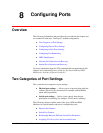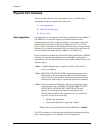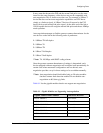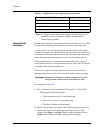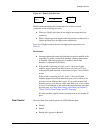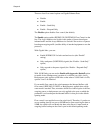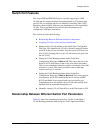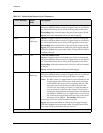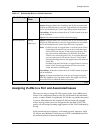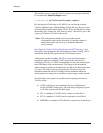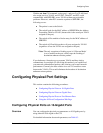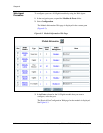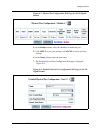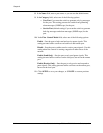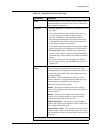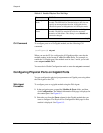
Document No. 10-300077, Issue 2 8-9
Configuring Ports
Assigning VLANs to a Port and Associated Issues
There are two ways to assign VLANs to ports on the Avaya Multiservice
Switch. You configure the Port(s) to the VLAN desired for the individual
port(s), or entire module. Assigning the VLAN this way enables the port(s)
to receive information for the assigned VLAN and causes all untagged
frames arriving on this port to be assigned to the specified VLAN. The
port(s) will still assign incoming tagged packets to the VLAN indicated by
the tag.
In the current release of software, a non-trunk port only supports a single
VLAN per port. Multiple VLANs per port is NOT recommended and can
have adverse effects on network performance.
Bind to Received Clear NOT RECOMMENDED
Ingress: Untagged frames are classified to the VLAN associated with
the port on which the frame is received. Tagged frames are classified to
the VLAN identified by the VLAN tag in the tag header of the frame.
Forwarding: All broadcast frames from all VLANs learned on the port
will be forwarded.
Egress: All frames transmitted will be sent with no tagging.
Bind to Received 802.1Q
Multi-layer
Ingress: Untagged frames are classified to the VLAN associated with
the port on which the frame is received. Tagged frames are classified to
the VLAN identified by the VLAN tag in the frame’s tag header.
Note: For 802.1q mode: if a tagged frame is received, but the VLAN
for that tagged frame does not exist on the switch, that frame
will be placed onto the port VLAN assigned to the port. This
may cause unicast and broadcast VLAN traffic from other
VLANs to be seen on the port VLAN. To avoid this behavior,
you can set the port VLAN into the “discard” VLAN which
will drop all untagged frames and tagged frames with unknown
VLAN IDs.
For Multi-layer and 3Com mode: if a tagged frame is received,
but the VLAN for that tagged frame does not exists on the
switch, that frame will be dropped.
Forwarding: All broadcast frames from all VLANs learned on the port
will be forwarded.
Egress: All frames transmitted out of the port to be tagged using the
IEEE 802.1Q/Multi-Layer tag header format. The tagged used will be
that of the VLAN in which the frame was received.
Table 8-2. Relationship Between Switch Parameters
VLAN Binding Trunk
Mode
Description
2 of 2



